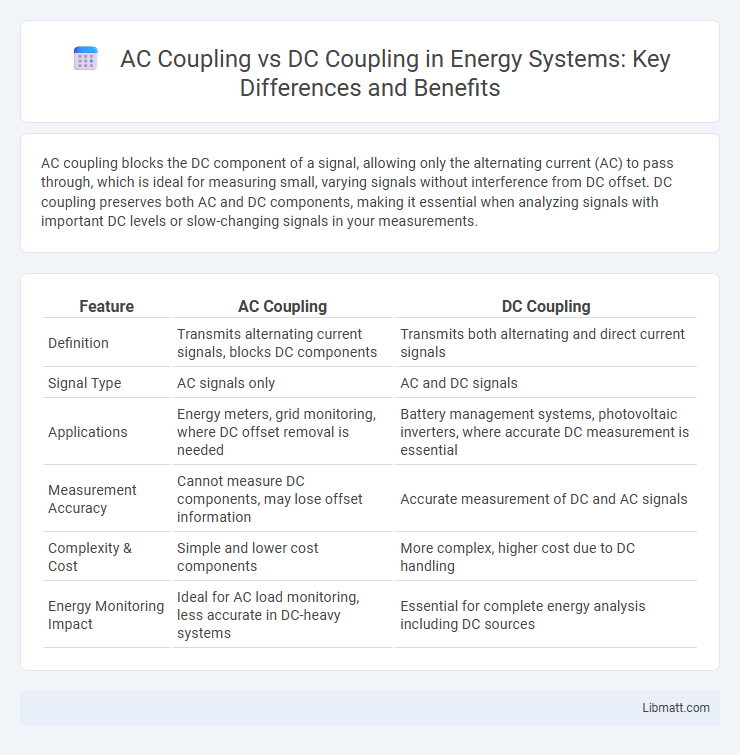AC coupling blocks the DC component of a signal, allowing only the alternating current (AC) to pass through, which is ideal for measuring small, varying signals without interference from DC offset. DC coupling preserves both AC and DC components, making it essential when analyzing signals with important DC levels or slow-changing signals in your measurements.
Table of Comparison
| Feature | AC Coupling | DC Coupling |
|---|---|---|
| Definition | Transmits alternating current signals, blocks DC components | Transmits both alternating and direct current signals |
| Signal Type | AC signals only | AC and DC signals |
| Applications | Energy meters, grid monitoring, where DC offset removal is needed | Battery management systems, photovoltaic inverters, where accurate DC measurement is essential |
| Measurement Accuracy | Cannot measure DC components, may lose offset information | Accurate measurement of DC and AC signals |
| Complexity & Cost | Simple and lower cost components | More complex, higher cost due to DC handling |
| Energy Monitoring Impact | Ideal for AC load monitoring, less accurate in DC-heavy systems | Essential for complete energy analysis including DC sources |
Understanding AC Coupling: Definition and Principles
AC coupling refers to the method of transmitting only the alternating current (AC) component of a signal by blocking the direct current (DC) component through a capacitor or transformer. This technique allows measurement systems, such as oscilloscopes, to focus on varying signal changes without DC offset interference, enhancing signal clarity. The principle hinges on high-pass filtering, where low-frequency and DC components are removed, preserving rapid voltage fluctuations for accurate analysis.
What is DC Coupling? Key Concepts Explained
DC coupling allows the transmission of both alternating current (AC) and direct current (DC) signals without distortion or loss of baseline information, enabling accurate low-frequency and DC signal measurements. This method maintains the integrity of the signal's true voltage level by providing a continuous electrical connection between the source and measurement device. Essential for applications like sensor data acquisition and power supply monitoring, DC coupling ensures precise representation of slow-changing or static signals.
Core Differences Between AC Coupling and DC Coupling
AC coupling blocks the direct current (DC) component of a signal, allowing only the alternating current (AC) variations to pass through, which is ideal for measuring small AC signals superimposed on a large DC offset. DC coupling, on the other hand, passes both AC and DC components, providing a complete signal representation necessary for monitoring steady-state levels and slow-changing signals. Understanding these core differences helps you select the appropriate coupling mode for accurate signal analysis in oscilloscopes and other measurement equipment.
Applications of AC Coupling in Electronics
AC coupling is primarily used in signal processing to block DC components while allowing alternating current (AC) signals to pass, making it ideal for applications such as audio equipment, oscilloscopes, and communication systems. It enables accurate measurement and analysis of AC waveforms by eliminating DC offset and preventing distortion in amplifiers and filters. This coupling technique is essential in amplifying small AC signals superimposed on DC voltage levels without altering the original signal characteristics.
DC Coupling Use Cases in Modern Circuits
DC coupling is essential in modern circuits requiring accurate representation of both AC and DC signals, such as in sensor outputs, battery monitoring, and low-frequency analog signal processing. It enables direct measurement of voltage levels without distortion or baseline shift, crucial for precision instrumentation and control systems. DC coupling also supports real-time feedback loops in power supply regulation and audio amplifiers, ensuring signal integrity across the entire frequency spectrum.
Advantages of AC Coupling
AC coupling provides the advantage of blocking DC voltage components, allowing measurement of small AC signals superimposed on large DC offsets without distortion. It prevents saturation of input amplifiers and improves signal integrity when analyzing varying signal frequencies. This makes AC coupling ideal for applications requiring isolation of alternating current characteristics from steady-state direct current levels.
Benefits of DC Coupling
DC coupling allows direct transmission of both AC and DC signals without distortion or loss, preserving the original waveform's integrity. It is essential for applications requiring accurate measurement of low-frequency signals or steady-state voltage levels, such as sensor outputs or power supply monitoring. Your circuits benefit from enhanced signal fidelity and expanded measurement capabilities when using DC coupling.
Limitations and Challenges: AC vs DC Coupling
AC coupling introduces limitations such as signal distortion and loss of low-frequency components due to the capacitor blocking DC offset, making it less suitable for measurements involving slow or steady signals. DC coupling preserves the entire signal waveform, including DC levels, but faces challenges like baseline drift and saturation in high amplitude signals, potentially complicating data interpretation. Your choice between AC and DC coupling depends on the specific measurement requirements and the trade-offs related to signal integrity and instrument limitations.
Choosing Between AC and DC Coupling: Practical Considerations
Choosing between AC coupling and DC coupling depends on the signal characteristics and measurement goals; AC coupling blocks DC components to focus on varying signals, making it ideal for analyzing small AC signals superimposed on large DC offsets. DC coupling preserves both AC and DC components, enabling accurate measurement of signal baseline and low-frequency information, essential in applications requiring full waveform analysis. Your decision should consider signal frequency, amplitude range, and the need to either isolate dynamic changes or include steady-state levels for precise data acquisition.
AC Coupling vs DC Coupling: Summary and Recommendations
AC coupling blocks DC components, allowing only AC signals to pass, which is ideal for measuring small AC variations superimposed on large DC offsets. DC coupling preserves both AC and DC signals, providing a true representation of the input waveform, crucial for applications requiring accurate voltage level measurements. Your choice depends on the signal characteristics: use AC coupling to isolate AC signals from DC bias, and select DC coupling when the full signal waveform, including its DC level, must be analyzed.
AC coupling vs DC coupling Infographic

 libmatt.com
libmatt.com